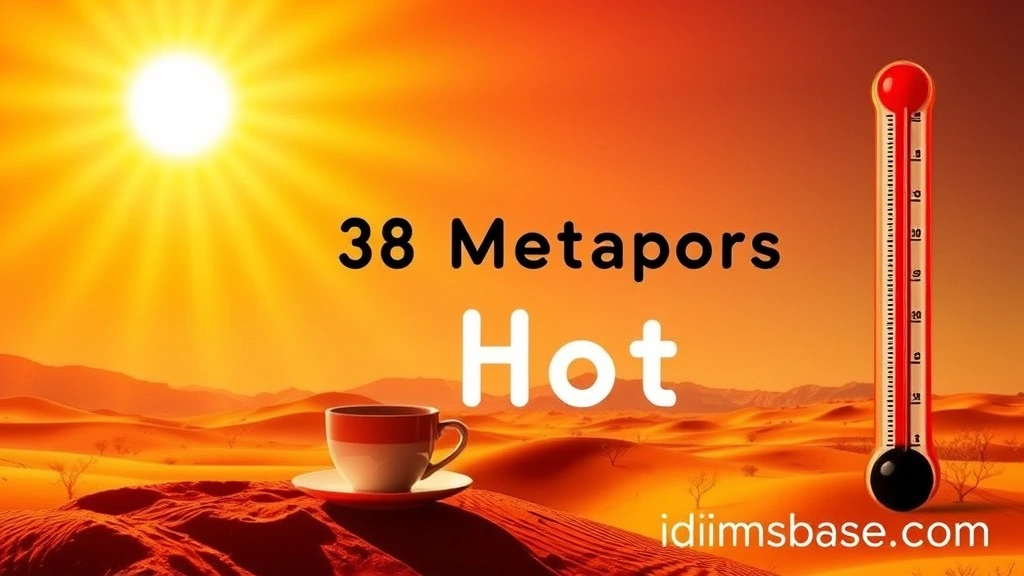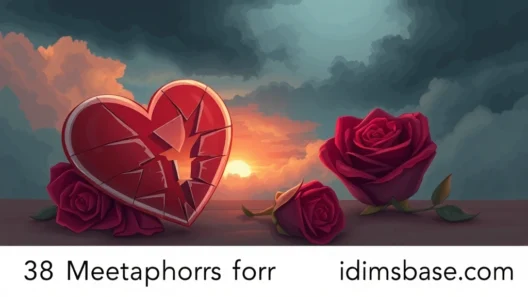Have you ever tried to describe something incredibly, overwhelmingly hot, but felt like "hot" just wasn't cutting it? You know, when the sun feels like a giant magnifying glass, or your chili is practically breathing fire? Sometimes, the best way to convey that intense heat isn't by stating the obvious, but by drawing a vivid picture with words. That's where metaphors come in!
Metaphors are like magic wands for language, allowing us to compare two unlike things without using "like" or "as." They paint a more vibrant, immediate image in your mind. And when it comes to "hot," boy, do we have some fiery comparisons for you! Let's dive into 38 sizzling metaphors that will help you describe heat in the most imaginative ways.
Sizzling Metaphors for "Hot"
Get ready to ignite your vocabulary! These metaphors are perfect for everything from scorching weather to spicy food, passionate emotions to intense situations.
-
A furnace: Imagine the intense, dry heat of an industrial furnace.
- Example: "The desert felt like a furnace, baking everything under its relentless sun."
-
A cauldron: Think of a witch's bubbling cauldron, full of simmering intensity.
- Example: "The summer air was a swirling cauldron of humidity."
-
A firecracker: Quick, explosive, and full of sudden heat.
- Example: "Her temper was a firecracker, ready to ignite at any moment."
-
A branding iron: The kind of heat that leaves a lasting mark.
- Example: "The sun was a branding iron on my skin, leaving it red and sensitive."
-
A blast furnace: Even more intense than a regular furnace, used for smelting metals.
- Example: "Stepping outside felt like walking into a blast furnace."
-
A volcano: Unpredictable, powerful, and spewing molten rock.
- Example: "His anger was a dormant volcano, threatening to erupt."
-
A dragon's breath: Mythical and terrifyingly hot.
- Example: "The chili sauce was pure dragon's breath."
-
A solar flare: An explosion on the sun's surface, radiating immense heat.
- Example: "The midday sun was a solar flare, blinding and scorching."
-
A heat lamp: Focused, direct, and warming.
- Example: "Her gaze was a heat lamp, making me feel exposed."
-
A grill: Where food sizzles and cooks over intense heat.
- Example: "The asphalt was a grill, radiating waves of heat."
-
A pressure cooker: Building intense heat and steam inside.
- Example: "The room was a pressure cooker, everyone sweating and agitated."
-
A supernova: A star exploding, releasing unimaginable energy and heat.
- Example: "The feeling of love was a supernova inside her chest."
-
A kiln: Used for firing pottery at extremely high temperatures.
- Example: "The air in the ceramics studio was a kiln, thick with heat."
-
A desert oven: The natural, dry heat of a vast desert.
- Example: "Our car became a desert oven after sitting in the sun all day."
-
A burning ember: Small, but still glowing with intense heat.
- Example: "Even after the fire died down, the coals were still burning embers."

-
A living flame: Implies an active, almost sentient heat.
- Example: "Her passion for art was a living flame within her."
-
A fiery inferno: A large, uncontrolled, and destructive fire.
- Example: "The old factory was a fiery inferno by the time firefighters arrived."
-
A summer's embrace: A warm, comforting, yet sometimes overwhelming heat.
- Example: "The afternoon sun was a summer's embrace, lulling us to sleep."
-
A fever: The internal heat of a sick body.
- Example: "The atmosphere in the room was a fever, tense and uncomfortable."
-
A hot plate: Simple, direct, and used for cooking.
- Example: "The metal bench was a hot plate under the sun."
-
A sunbeam: A concentrated beam of sunlight, carrying warmth.
- Example: "His smile was a sunbeam, warming everyone around him."
-
A chili pepper: Small, but packing a powerful, spicy heat.
- Example: "Her wit was a chili pepper, sharp and surprising."
-
A radiator: Emitting steady, consistent warmth.
- Example: "His presence was a radiator, filling the room with comfort."
-
A forge: Where metal is heated and shaped by a blacksmith.
- Example: "The debate became a forge, ideas clashing and reforming."
-
A core reactor: The intensely hot heart of a nuclear reactor.
- Example: "His determination was a core reactor, unstoppable."

-
A burning coal: Similar to an ember, but perhaps larger and more immediate.
- Example: "The pain in his leg was a burning coal."
-
A steam bath: Enveloping, moist heat.
- Example: "The bathroom after her shower was a steam bath."
-
An oven: A common kitchen appliance for baking and roasting.
- Example: "Our car's interior was an oven in the parking lot."
-
A blowtorch: Focused, intense, and capable of melting.
- Example: "The critic's words were a blowtorch, searing his confidence."
-
A heatwave: A period of unusually hot weather.
- Example: "The tension in the office was a heatwave, making everyone irritable."
-
A bonfire: Large, inviting, and radiating significant heat.
- Example: "The party was a bonfire of energy and laughter."
-
A hot zone: A dangerous area due to extreme heat or radiation.
- Example: "The argument quickly turned into a hot zone."
-
A simmering pot: Not quite boiling, but building towards intensity.
- Example: "The resentment was a simmering pot, ready to boil over."
-
A glowing heart: Suggests internal, deep-seated warmth or passion.
- Example: "Despite the cold, she had a glowing heart."
-
A fireball: A sudden, intense burst of fire.
- Example: "The explosion was a sudden fireball."

-
A sun-drenched canvas: Implies a beautiful, pervasive warmth.
- Example: "The garden was a sun-drenched canvas in the afternoon."
-
A torrid zone: A geographical region known for its intense heat.
- Example: "Their relationship entered a torrid zone of passion."
-
A crucible: A container used for very high-temperature chemical reactions, implying transformative heat.
- Example: "The intense training was a crucible that forged her strength."
FAQs: Unpacking the Power of Metaphors
You might be wondering why metaphors are so effective, or how to use them best. Let's explore some common questions.
Q1: What's the difference between a metaphor and a simile?
A simile is a direct comparison between two unlike things using "like" or "as." For example, "The sun was like a furnace." A metaphor, on the other hand, states that one thing is another. "The sun was a furnace." Metaphors are generally more powerful and create a stronger image because they assert a direct identity.
Q2: Why should I use metaphors in my writing?
Metaphors make your writing more vivid, engaging, and memorable. They help readers visualize and feel what you're describing, adding depth and emotion. Instead of just saying "it was hot," saying "it was a blast furnace" immediately conveys a much more intense and specific kind of heat. They also show creativity and sophistication in your language!
Q3: Can I create my own metaphors for "hot"?
Absolutely! The best metaphors often come from your own observations and imagination. Think about different things that are hot, or situations that feel hot, and then try to find unexpected connections. For example, what else feels like a furnace? A crowded subway car in summer, perhaps? Then, "The subway car was a furnace."
Q4: Are there any rules for using metaphors?
While creativity is key, here are a few tips:
- Keep it fresh: Avoid clichés if possible. "Hot as hell" is an old one; try to find something more original.
- Make it relevant: The comparison should make sense in context and illuminate what you're trying to describe.
- Don't overdo it: A few well-placed metaphors are more effective than pages full of them. Let them shine!
Q5: Can metaphors be used in everyday conversation?
Yes, they definitely can! While often associated with poetry and literature, metaphors pepper our daily speech. When you say someone "exploded with anger" or that an idea "ignited a passion," you're using metaphors. They make our conversations more colorful and expressive.
Key Takeaways
- Metaphors for "hot" allow you to move beyond simple descriptions and paint vivid, imaginative pictures with words.
- They create a stronger impact than similes because they state that one thing is another (e.g., "The desert was a furnace").
- Using metaphors enhances your writing by making it more engaging, memorable, and emotionally resonant.
- Don't be afraid to create your own unique metaphors by thinking about unexpected connections.
- Effective metaphors are fresh, relevant, and used judiciously to maximize their impact.
So, the next time you need to describe something truly scorching, remember these fiery metaphors. Your language will thank you for it, and your readers will feel the heat! Which one of these metaphors is your favorite, or do you have a new one to share? Let us know!






